2016 HONDA CIVIC COUPE brake
[x] Cancel search: brakePage 426 of 585
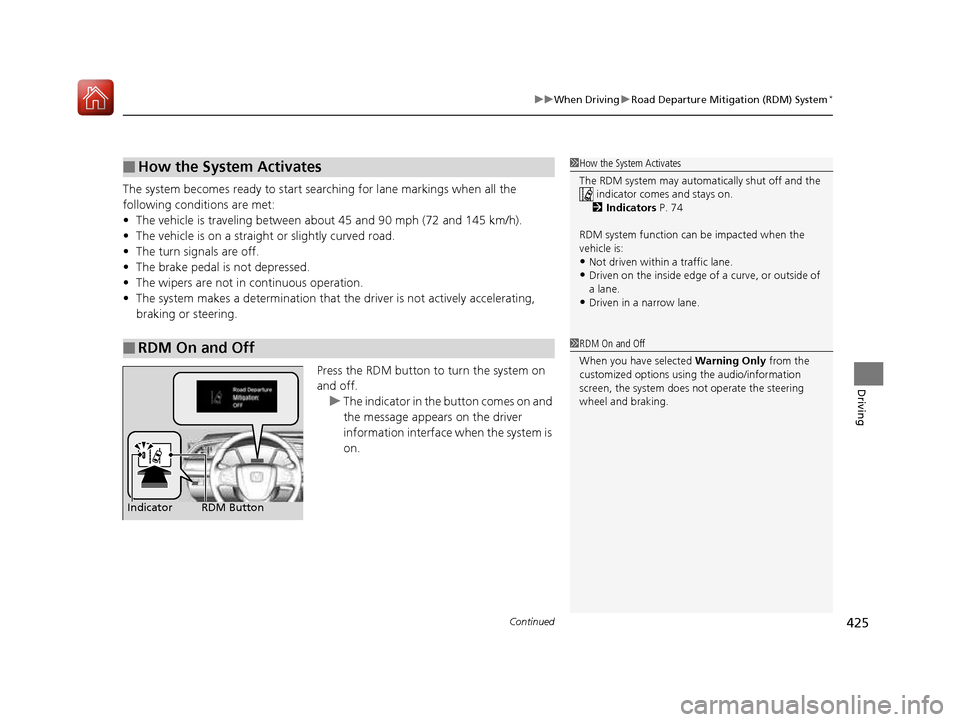
Continued425
uuWhen DrivinguRoad Departure Mitigation (RDM) System*
Driving
The system becomes ready to start sear
ching for lane markings when all the
following conditions are met: • The vehicle is traveling between about 45 and 90 mph (72 and 145 km/h).
• The vehicle is on a straight or slightly curved road.
• The turn signals are off.
• The brake pedal is not depressed.
• The wipers are not in continuous operation.
• The system makes a determination that th e driver is not actively accelerating,
braking or steering.
Press the RDM button to turn the system on and off.
uThe indicator in the button comes on and
the message appears on the driver
information interface when the system is
on.
■How the System Activates
■RDM On and Off
1How the System Activates
The RDM system may automa tically shut off and the
indicator comes and stays on.
2 Indicators P. 74
RDM system function can be impacted when the
vehicle is: • Not driven within a traffic lane.
• Driven on the inside edge of a curve, or outside of
a lane.
• Driven in a narrow lane.
1RDM On and Off
When you have selected Warning Only from the
customized options using the audio/information
screen, the system does not operate the steering
wheel and braking.
RDM Button
Indicator
16 CIVIC 2D HC2 (0A 01 0C)-31TBG6000.book 425 ページ >0>.>/6年>0月>/>0日 金曜日 午後4時>/6分
Page 431 of 585

uuWhen DrivinguLane Keeping Assist System (LKAS)*
430
Driving
The system can be used when the following conditions are met.
• The lane in which you are driving has dete ctable lane markers on both sides, and
your vehicle is in the center of the lane.
• The vehicle speed is between 45 and 90 mph (72 and 145 km/h).
• You are driving on a straight or slightly curved road.
• The turn signals are off.
• The brake pedal is not depressed.
• The wipers are not in continuous operation.
■ How to activate the system
1.Press the MAIN button.
uThe LKAS is on in the driver information interface.
The system is ready to use.
2. Press the LKAS button.
uLane outlines appear on the driver
information interface.
The system is activated.
■When the System can be Used1When the System can be Used
If the vehicle drifts toward either the left or right lane line due to the system appl ying torque, turn off the
LKAS and have your vehi cle checked by a dealer.
MAIN Button
LKAS Button
16 CIVIC 2D HC2 (0A 01 0C)-31TBG6000.book 430 ページ >0>.>/6年>0月>/>0日 金曜日 午後4時>/6分
Page 433 of 585
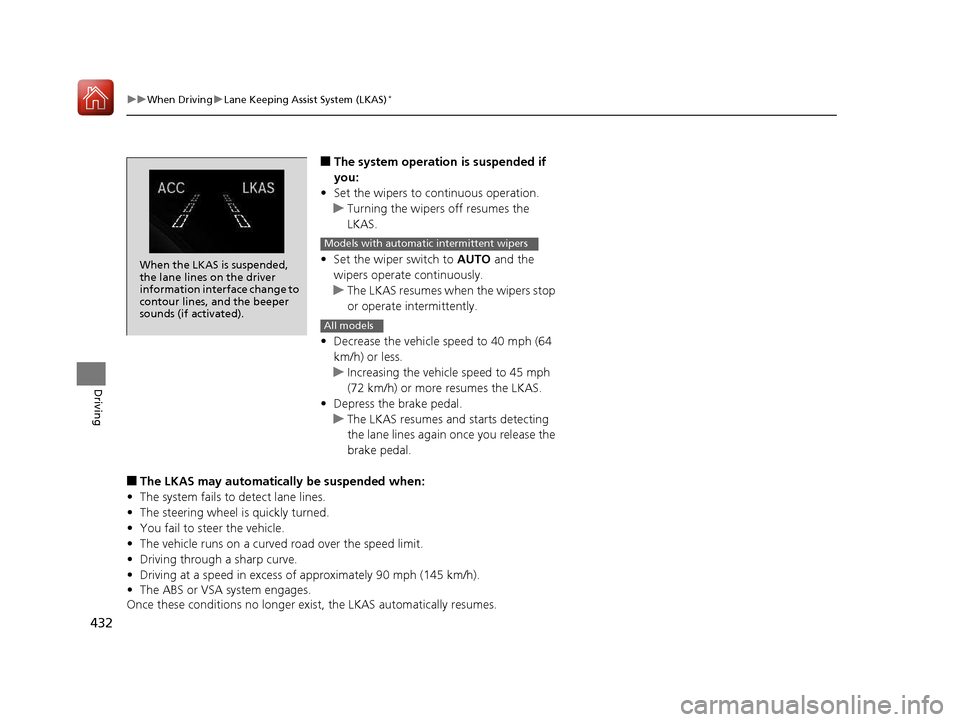
432
uuWhen DrivinguLane Keeping Assist System (LKAS)*
Driving
■
The system operation is suspended if
you:
• Set the wipers to continuous operation.
uTurning the wipers off resumes the
LKAS.
• Set the wiper switch to AUTO and the
wipers operate continuously.
uThe LKAS resumes when the wipers stop
or operate intermittently.
• Decrease the vehicle speed to 40 mph (64
km/h) or less.
uIncreasing the vehicle speed to 45 mph
(72 km/h) or more resumes the LKAS.
• Depress the brake pedal.
uThe LKAS resumes and starts detecting
the lane lines again once you release the
brake pedal.
■ The LKAS may automatically be suspended when:
• The system fails to detect lane lines.
• The steering wheel is quickly turned.
• You fail to steer the vehicle.
• The vehicle runs on a curved road over the speed limit.
• Driving through a sharp curve.
• Driving at a speed in excess of approximately 90 mph (145 km/h).
• The ABS or VSA system engages.
Once these conditions no longer exis t, the LKAS automatically resumes.
When the LKAS is suspended,
the lane lines on the driver
information interface change to
contour lines, and the beeper
sounds (if activated).
Models with automatic intermittent wipers
All models
16 CIVIC 2D HC2 (0A 01 0C)-31TBG6000.book 432 ページ >0>.>/6年>0月>/>0日 金曜日 午後4時>/6分
Page 436 of 585
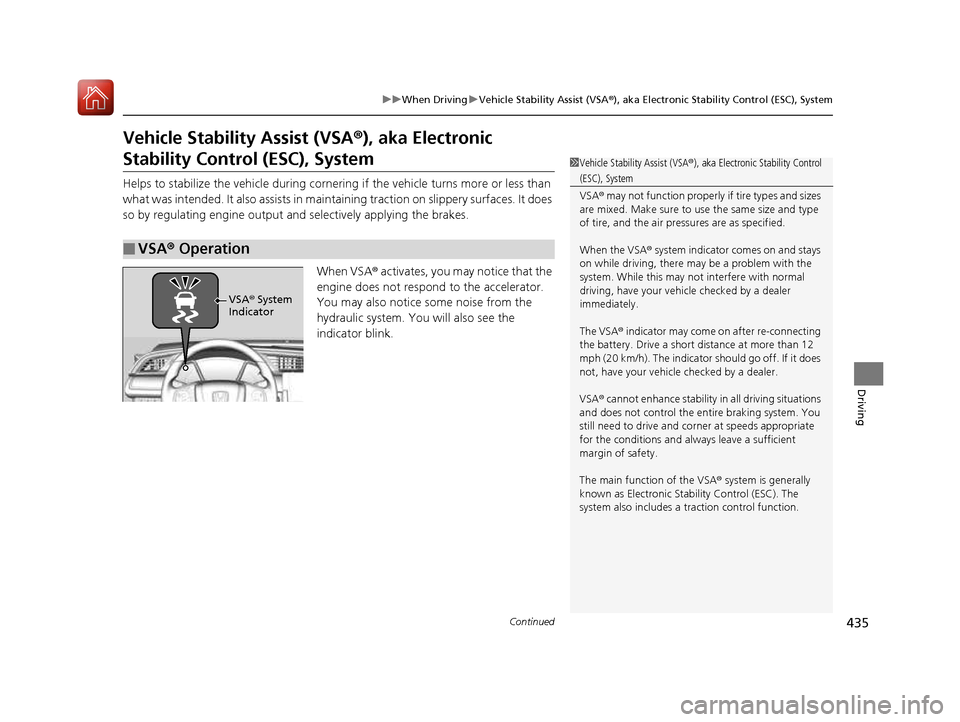
435
uuWhen DrivinguVehicle Stability Assist (VSA®), aka Electronic Stability Control (ESC), System
Continued
Driving
Vehicle Stability Assist (VSA ®), aka Electronic
Stability Control (ESC), System
Helps to stabilize the vehicl e during cornering if the vehicle turns more or less than
what was intended. It also assists in main taining traction on slippery surfaces. It does
so by regulating engine output and selectively applying the brakes.
When VSA® activates, you may notice that the
engine does not respond to the accelerator.
You may also notice some noise from the
hydraulic system. You will also see the
indicator blink.
■VSA ® Operation
1Vehicle Stability Assist (VSA ®), aka Electronic Stability Control
(ESC), System
VSA ® may not function properly if tire types and sizes
are mixed. Make sure to use the same size and type
of tire, and the air pressures are as specified.
When the VSA ® system indicator comes on and stays
on while driving, there ma y be a problem with the
system. While this may not interfere with normal
driving, have your vehi cle checked by a dealer
immediately.
The VSA ® indicator may come on after re-connecting
the battery. Drive a short distance at more than 12
mph (20 km/h). The indicator should go off. If it does
not, have your vehicle checked by a dealer.
VSA ® cannot enhance stability in all driving situations
and does not control the entire braking system. You
still need to drive and corner at speeds appropriate
for the conditions and always leave a sufficient
margin of safety.
The main function of the VSA ® system is generally
known as Electronic Stability Control (ESC). The
system also includes a traction control function.
VSA® System
Indicator
16 CIVIC 2D HC2 (0A 01 0C)-31TBG6000.book 435 ページ >0>.>/6年>0月>/>0日 金曜日 午後4時>/6分
Page 438 of 585
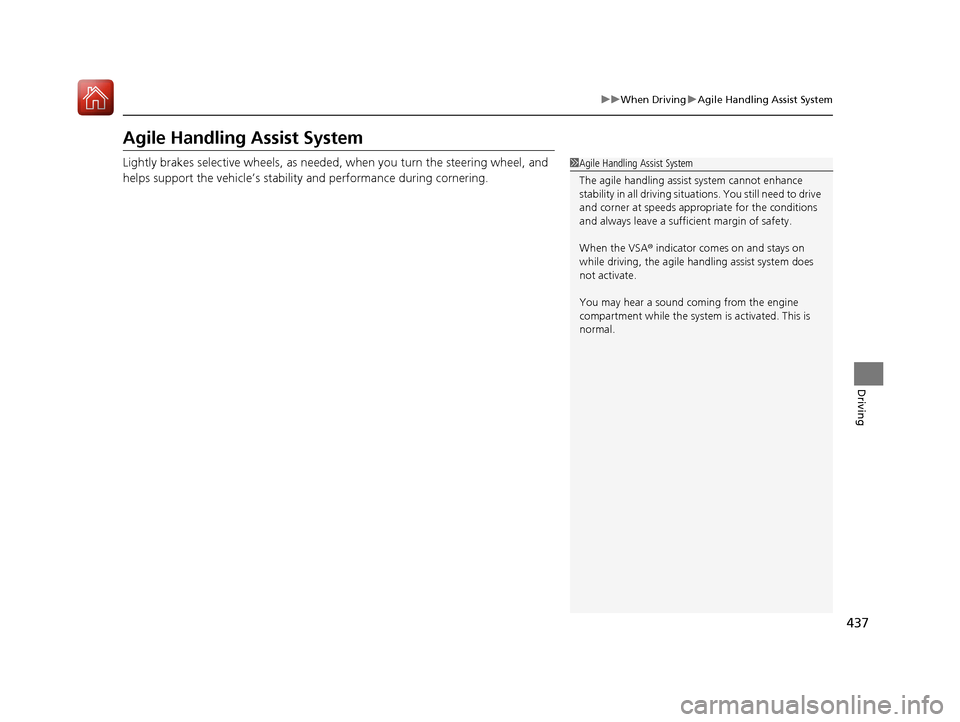
437
uuWhen DrivinguAgile Handling Assist System
Driving
Agile Handling Assist System
Lightly brakes selective wheels, as needed, when you turn the steering wheel, and
helps support the vehicle’s stability and performance during cornering.
1Agile Handling Assist System
The agile handling assist system cannot enhance
stability in all driving situat ions. You still need to drive
and corner at speeds appr opriate for the conditions
and always leave a sufficient margin of safety.
When the VSA ® indicator comes on and stays on
while driving, the agile handling assist system does not activate.
You may hear a sound coming from the engine
compartment while the system is activated. This is normal.
16 CIVIC 2D HC2 (0A 01 0C)-31TBG6000.book 437 ページ >0>.>/6年>0月>/>0日 金曜日 午後4時>/6分
Page 446 of 585
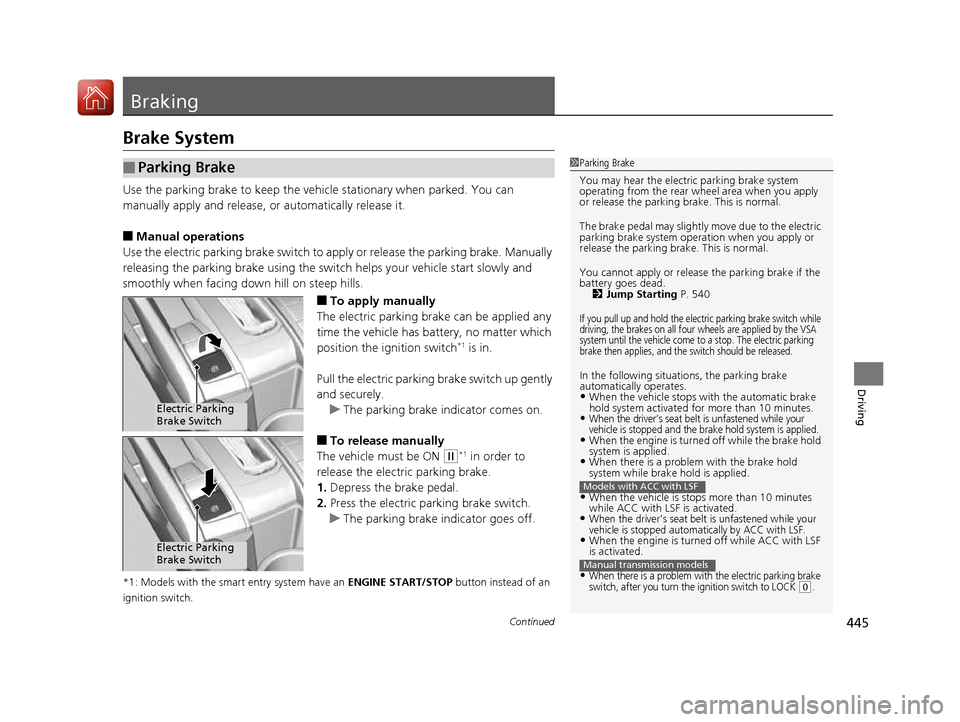
445
Continued
Driving
Braking
Brake System
Use the parking brake to keep the vehicle stationary when parked. You can
manually apply and release,
or automatically release it.
■ Manual operations
Use the electric parking brake switch to a pply or release the parking brake. Manually
releasing the parking brake using the switch helps your vehicle start slowly and
smoothly when facing down hill on steep hills.
■To apply manually
The electric parking brake can be applied any
time the vehicle has battery, no matter which
position the ignition switch *1
is in.
Pull the electric parking brake switch up gently
and securely.
uThe parking brake indicator comes on.
■ To release manually
The vehicle must be ON
(w *1
in order to
release the electric parking brake. 1. Depress the brake pedal.
2. Press the electric parking brake switch.
uThe parking brake indicator goes off.
*1: Models with the smart entry system have an ENGINE START/STOP button instead of an
ignition switch.
■Parking Brake1Parking Brake
You may hear the electric parking brake system
operating from the rear wh eel area when you apply
or release the parking brake. This is normal.
The brake pedal may slightly move due to the electric
parking brake system opera tion when you apply or
release the parking br ake. This is normal.
You cannot apply or release the parking brake if the
battery goes dead.
2 Jump Starting P. 540
If you pull up and hold the electric parking brake switch while
driving, the brakes on all four wheels are applied by the VSA
system until the vehicle come to a stop. The electric parking
brake then applies, and the switch should be released.
In the following situations, the parking brake
automatically operates.•When the vehicle stops with the automatic brake
hold system activated for more than 10 minutes.
•When the driver’s seat belt is unfastened while your
vehicle is stopped and the brake hold system is applied.
•When the engine is turned off while the brake hold system is applied.
• When there is a problem with the brake hold
system while brake hold is applied.
• When the vehicle is stops more than 10 minutes
while ACC with LSF is activated.
•When the driver’s seat belt is unfastened while your
vehicle is stopped automatically by ACC with LSF.
•When the engine is turned off while ACC with LSF
is activated.
•When there is a problem with the electric parking brake
switch, after you turn the ignition switch to LOCK (0.
Models with ACC with LSF
Manual transmission models
Electric Parking
Brake Switch
Electric Parking Brake Switch
16 CIVIC 2D HC2 (0A 01 0C)-31TBG6000.book 445 ページ >0>.>/6年>0月>/>0日 金曜日 午後4時>/6分
Page 447 of 585
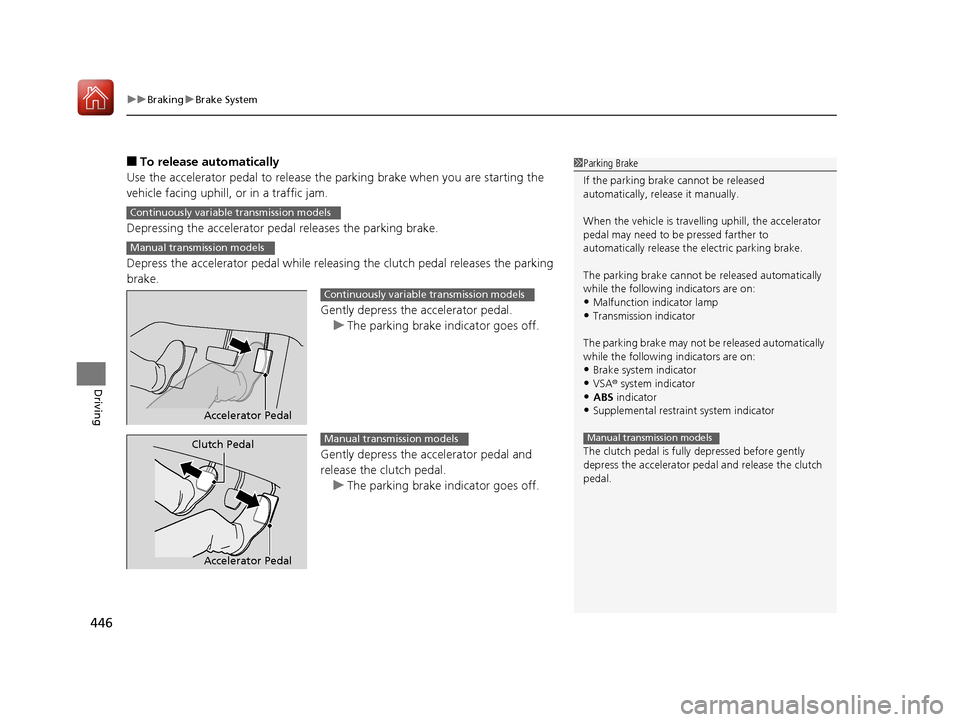
uuBrakinguBrake System
446
Driving
■ To release automatically
Use the accelerator pedal to release the parking brake when you are starting the
vehicle facing uphill, or in a traffic jam.
Depressing the accelerator pedal releases the parking brake.
Depress the accelerator pedal while releasi ng the clutch pedal releases the parking
brake.
Gently depress the accelerator pedal.
uThe parking brake indicator goes off.
Gently depress the accelerator pedal and
release the clutch pedal.
uThe parking brake indicator goes off.
1Parking Brake
If the parking brake cannot be released
automatically, release it manually.
When the vehicle is travelling uphill, the accelerator
pedal may need to be pressed farther to
automatically release the electric parking brake.
The parking brake cannot be released automatically
while the following indicators are on:
• Malfunction indicator lamp
• Transmission indicator
The parking brake may not be released automatically
while the following indicators are on:
• Brake system indicator
• VSA ® system indicator
• ABS indicator
• Supplemental restraint system indicator
The clutch pedal is fully depressed before gently
depress the accelerator peda l and release the clutch
pedal.
Manual transmission models
Continuously variable transmission models
Manual transmission models
Accelerator Pedal
Continuously variable transmission models
Accelerator Pedal
Clutch PedalManual transmission models
16 CIVIC 2D HC2 (0A 01 0C)-31TBG6000.book 446 ページ >0>.>/6年>0月>/>0日 金曜日 午後4時>/6分
Page 448 of 585
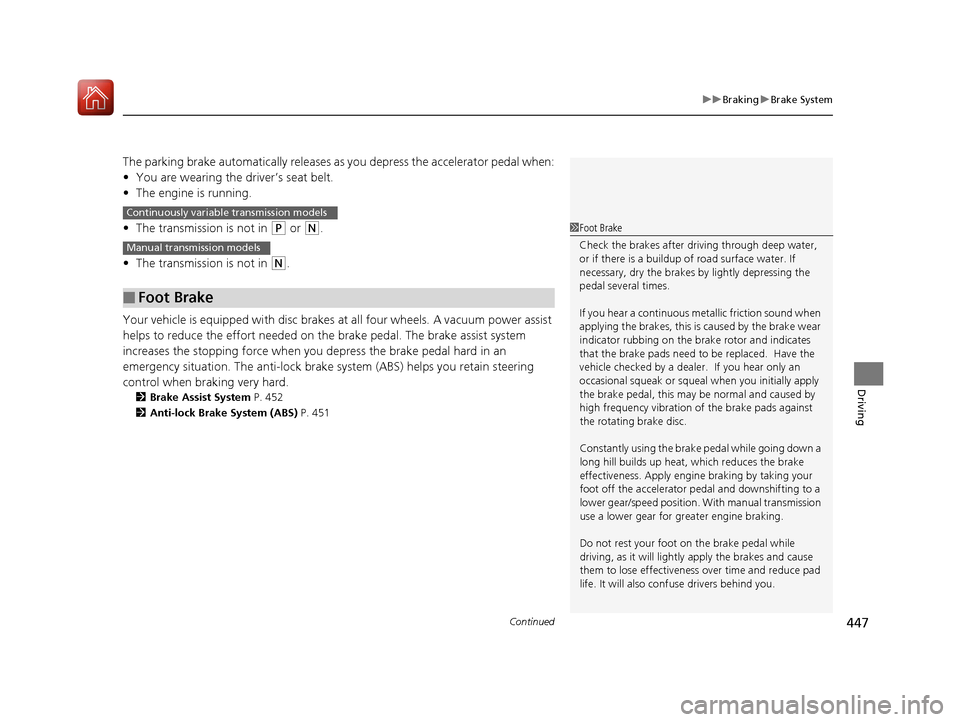
Continued447
uuBrakinguBrake System
Driving
The parking brake automatically releases as you depress the accelerator pedal when:
• You are wearing the driver’s seat belt.
• The engine is running.
• The transmission is not in
(P or (N .
• The transmission is not in
(N .
Your vehicle is equipped with disc brakes at all four wheels. A vacuum power assist
helps to reduce the effort needed on th e brake pedal. The brake assist system
increases the stopping force when you depress the brake pedal hard in an
emergency situation. The an ti-lock brake system (ABS) helps you retain steering
control when brak ing very hard.
2 Brake Assist System P. 452
2 Anti-lock Brake System (ABS) P. 451
■Foot Brake
Continuously variable transmission models
Manual transmission models
1Foot Brake
Check the brakes after driving through deep water,
or if there is a buildup of road surface water. If
necessary, dry the brakes by lightly depressing the
pedal several times. If you hear a continuous me tallic friction sound when
applying the brakes, this is caused by the brake wear
indicator rubbing on the brake rotor and indicates
that the brake pads need to be replaced. Have the
vehicle checked by a dealer. If you hear only an
occasional squeak or squeal when you initially apply
the brake pedal, this may be normal and caused by
high frequency vibr ation of the brake pads against
the rotating brake disc. Constantly using the brak e pedal while going down a
long hill builds up heat, which reduces the brake
effectiveness. Apply engine braking by taking your
foot off the accelerator pe dal and downshifting to a
lower gear/speed position. With manual transmission
use a lower gear for gr eater engine braking.
Do not rest your foot on the brake pedal while
driving, as it will lightly apply the brakes and cause
them to lose effectiveness over time and reduce pad
life. It will also conf use drivers behind you.
16 CIVIC 2D HC2 (0A 01 0C)-31TBG6000.book 447 ページ >0>.>/6年>0月>/>0日 金曜日 午後4時>/6分